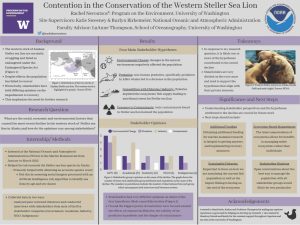Contention in the Conservation of the Western Steller Sea Lion
In Alaska the western stock of Steller sea lion are currently listed as endangered under the Endangered Species Act and the cause of the recent decline is still unknown. The aim of this study was to learn more about the potential causes of the decline as well as investigate how stakeholders’ opinions differ. During my time interning at NOAA I researched the Steller sea lion species and conducted research in two ways. First, I conducted thirty-minute interviews with stakeholders where I asked questions related to the decline and the current status of the population. Secondly, I conducted literature reviews on papers that addressed the various hypotheses behind the recent decline. Through my research I discovered that the main hypotheses for the decline are non-human predation, environmental change, competition with fisheries and exposure to contaminants. I also discovered that stakeholders have differing opinions on the decline and there is a lot of politics involved. A culmination of not knowing the ultimate cause of the decline and contention among stakeholder groups has led to a slow recovery. Despite this, there are a variety of solutions to help move us closer toward helping the western Steller sea lion recover. Some include focusing more on ecosystem-based management, cultivating a sense of unification among stakeholders, obtaining more funding for marine mammal research and lastly emphasizing sustainable fisheries management. Steller sea lion play a crucial role in the Alaskan marine ecosystem; saving them would help and protect many of the species we rely on and love.
